Citation:
| Full_text.pdf | 1.47 MB |
Abstract:
The study of core electron dynamics through nonlinear spectroscopy requires intense isolated attosecond extreme ultraviolet or even X-ray pulses. A robust way to produce these pulses is high-harmonic generation (HHG) in a gas medium. However, the energy upscaling of the process depends on a very demanding next-generation laser technology that provides multi-terawatt (TW) laser pulses with few-optical-cycle duration and controlled electric field. Here, we revisit the HHG process driven by 16-TW sub-two-cycle laser pulses to reach high intensity in the 100-eV spectral region and beyond. We show that the combination of above barrier-suppression intensity with a long generation medium significantly enhances the isolation of attosecond pulses compared to lower intensities and/or shorter media and this way reduces the pulse duration as well as field-stability requirements on the laser driver. This novel regime facilitates the real-time observation of electron dynamics at the attosecond timescale in atoms, molecules, and solids.

